Detecting Plant Invasion in Urban Parks with Aerial Image Time Series and Residual Neural Network
Abstract
1. Introduction
2. Materials and Methods
2.1. Study Area
2.2. Field Data
2.3. Aerial Image Time Series
2.4. Invasive Species Detection
2.4.1. Evaluation Framework and Justification
- Evaluation One: The purpose of the first category of evaluation was to understand ResNet’s spatial generalization ability from one park to another and the effects of training sample size (i.e., number of parks). This is particularly valuable for efficiently managing urban parks like those in Charlotte (an area of 1410 km2), which spread across the entire city region. The long travelling distances between parks prevent frequent field surveys. In this study, we randomly selected four parks (Auten, Reedy Creek, Rural Hill, and Stevens Creek) and used the sample plots from those parks for model validation. This was followed by a random selection of four different numbers of parks (i.e., 4, 8, 12, and 16) from the remainder for model training. Here, the use of the same validation data was intended to ensure a fair comparison of model performance when the size of training samples varied from small to large. For the same reason, we did not use k-fold cross validation.
- Evaluation Two: The second category of evaluation was designed to assess how deep learning responds to forest contextual variation over time. Such variation is typically associated with autumn olive’s progressive invasion and the change in illumination condition. In this study, we extracted training and validation samples in four different ways: (i) training—even years of samples (2012, 2014, 2016, and 2018), validation—odd years of samples (2013, 2014, and 2017); (ii) training—odd years of samples, validation—even years of samples; (iii) training—the first four years of data (2012–2015), validation—the last three years of data (2016–2018); and (iv) training the last three years of data (2016–2018), validation—the first four years of data. Tests (i) and (ii) were intended to assess the scenario that field surveys of plant invasion are not able to be conducted every year due to logistical challenges, although frequent invasion assessment on an annual basis is required to inform effective management. Tests (iii) and (iv) were designed for examining the potential of ResNet in forward and backward tracking of autumn olive, which progressively changed forest contextual variation following establishment. In all of the four tests we have tried to balance the amount of training and validation samples in order to reduce the impact of sample size on model performance.
2.4.2. Fine-Tuning Residual Neural Network (ResNet)
3. Results
4. Discussion
4.1. Spatial Generalization Capacity Across Parks
4.2. Effects of Image Contextual Variation Over Time
5. Conclusions
Author Contributions
Funding
Acknowledgments
Conflicts of Interest
References
- Ricciardi, A. Are modern biological invasions an unprecedented form of global change? Conserv. Biol. 2007, 21, 329–336. [Google Scholar] [CrossRef] [PubMed]
- Simberloff, D.; Vitule, J.R. A call for an end to calls for the end of invasion biology. Oikos 2014, 123, 408–413. [Google Scholar] [CrossRef]
- Invasive Alien Species: A Growing Problem for Environment and Health. Available online: http://www.eea.europa.eu/highlights/invasive-alien-species-a-growing (accessed on 26 September 2020).
- Qian, H.; Ricklefs, R.E. The role of exotic species in homogenizing the North American flora. Ecol. Lett. 2006, 9, 1293–1298. [Google Scholar] [CrossRef] [PubMed]
- Brown, C.E.; Pezeshki, S.R. A study on waterlogging as a potential tool to control Ligustrum sinense populations in western Tennessee. Wetlands 2000, 20, 429–437. [Google Scholar] [CrossRef]
- Malanson, G.P.; Walsh, S.J. A geographical approach to optimization of response to invasive species. In Science and Conservation in the Galapagos Islands; Walsh, S.J., Mena, C.F., Eds.; Springer: New York, NY, USA, 2013; pp. 199–215. [Google Scholar]
- Lass, L.W.; Thill, D.C.; Shafii, B.; Prather, T.S. Detecting spotted knapweed (Centaurea maculosa) with hyperspectral remote sensing technology. Weed Technol. 2002, 16, 426–432. [Google Scholar] [CrossRef]
- Asner, G.P.; Jones, M.O.; Martin, R.E.; Knapp, D.E.; Hughes, R.F. Remote sensing of native and invasive species in Hawaiian forests. Remote Sens. Environ. 2008, 112, 1912–1926. [Google Scholar] [CrossRef]
- Jones, T.G.; Coops, N.C.; Sharma, T. Assessing the utility of airborne hyperspectral and LiDAR data for species distribution mapping in the coastal Pacific Northwest, Canada. Remote Sens. Environ. 2010, 114, 2841–2852. [Google Scholar] [CrossRef]
- Somers, B.; Asner, G.P. Multi–temporal hyperspectral mixture analysis and feature selection for invasive species mapping in rainforests. Remote Sens. Environ. 2013, 136, 14–27. [Google Scholar] [CrossRef]
- Becker, R.H.; Zmijewski, K.A.; Crail, T. Seeing the forest for the invasives: Mapping buckthorn in the Oak Openings. Biol. Invasions 2013, 15, 315–326. [Google Scholar] [CrossRef]
- Schneider, L.C.; Fernando, D.N. An untidy cover: Invasion of bracken fern in the shifting cultivation systems of Southern Yucatán, Mexico. Biotropica 2010, 42, 41–48. [Google Scholar] [CrossRef]
- Fuller, D.O. Remote detection of invasive Melaleuca trees (Melaleuca quinquenervia) in South Florida with multispectral IKONOS imagery. Int. J. Remote Sens. 2005, 26, 1057–1063. [Google Scholar] [CrossRef]
- Underwood, E.; Ustin, S.; DiPietro, D. Mapping nonnative plants using hyperspectral imagery. Remote Sens. Environ. 2003, 86, 150–161. [Google Scholar] [CrossRef]
- da Luz, B.R.; Crowley, J.K. Identification of plant species by using high spatial and spectral resolution thermal infrared (8.0–13.5 µm) imagery. Remote Sens. Environ. 2010, 114, 404–413. [Google Scholar] [CrossRef]
- Ullah, S.; Schlerf, M.; Skidmore, A.K.; Hecker, C. Identifying plant species using mid–wave infrared (2.5–6 µm) and thermal infrared (8–14 µm) emissivity spectra. Remote Sens. Environ. 2012, 118, 95–102. [Google Scholar] [CrossRef]
- Albright, T.P.; Moorhouse, T.; McNabb, T. The rise and fall of water hyacinth in Lake Victoria and the Kagera River Basin, 1989–2001. J. Aquat. Plant Manag. 2004, 42, 73–84. [Google Scholar]
- Wu, Y.G.; Rutchey, K.; Wang, N.M.; Godin, J. The spatial pattern and dispersion of Lygodium microphyllum in the Everglades wetland ecosystem. Biol. Invasions 2006, 8, 1483–1493. [Google Scholar] [CrossRef]
- Everitt, J.H.; Yang, C. Using Quickbird Satellite imagery to distinguish two aquatic weeds in south Texas. J. Aquat. Plant Manag. 2007, 45, 25–31. [Google Scholar]
- Cavalli, R.M.; Laneve, G.; Fusilli, L.; Pignatti, S.; Santini, F. Remote sensing water observation for supporting Lake Victoria weed management. J. Environ. Manage. 2009, 90, 2199–2211. [Google Scholar] [CrossRef]
- Fletcher, R.S.; Everitt, J.H.; Elder, H.S. Evaluating airborne multispectral digital video to differentiate Giant Salvinia from other features in Northeast Texas. Remote Sens. 2010, 2, 2413–2423. [Google Scholar] [CrossRef]
- Hoyos, L.E.; Gavier–Pizarro, G.I.; Kuemmerle, T.; Bucher, E.H.; Radeloff, V.C.; Tecco, P.A. Invasion of glossy privet (Ligustrum lucidum) and native forest loss in the Sierras Chicas of Cordoba, Argentina. Biol. Invasions 2010, 12, 3261–3275. [Google Scholar] [CrossRef]
- Taylor, S.L.; Hill, R.A.; Edwards, C. Characterising invasive non–native Rhododendron ponticum spectra signatures with spectroradiometry in the laboratory and field: Potential for remote mapping. ISPRS J. Photogramm. Remote Sens. 2003, 81, 70–81. [Google Scholar] [CrossRef]
- Singh, K.K.; Chen, Y.H.; Smart, L.; Gray, J.; Meentemeyer, R.K. Intra-annual phenology for detecting understory plant invasion in urban forests. ISPRS J. Photogramm. Remote Sens. 2018, 142, 151–161. [Google Scholar] [CrossRef]
- Vilà, M.; Ibáñez, I. Plant invasions in the landscape. Landsc. Ecol. 2011, 26, 461–472. [Google Scholar] [CrossRef]
- Liu, M.; Li, M.; Li, L.; Man, W.; Jia, M.; Wang, Z.; Lu, C. Monitoring the Invasion of Spartina alterniflora Using Multi–source High–resolution Imagery in the Zhangjiang Estuary, China. Remote Sens. 2017, 9, 539. [Google Scholar] [CrossRef]
- Ng, W.T.; Rima, P.; Einzmann, K.; Immitzer, M.; Atzberger, C.; Eckert, S. Assessing the Potential of Sentinel–2 and Pléiades Data for the Detection of Prosopis and Vachellia spp. in Kenya. Remote Sens. 2017, 9, 74. [Google Scholar] [CrossRef]
- Mullerova, J.; Bruna, J.; Bartalos, T.; Dvorak, P.; Vitkova, M.; Pysek, P. Timing Is Important: Unmanned Aircraft vs. Satellite Imagery in Plant Invasion Monitoring. Front. Plant Sci. 2017, 8, 887. [Google Scholar] [CrossRef]
- Bradley, B.A. Remote detection of invasive plants: A review of spectral, textural and phenological approaches. Biol. Invasions 2014, 16, 1411–1425. [Google Scholar] [CrossRef]
- Perroy, R.L.; Sullivan, T.; Stephenson, N. Assessing the impacts of canopy openness and flight parameters on detecting a sub-canopy tropical invasive plant using a small unmanned aerial system. ISPRS J. Photogramm. Remote Sens. 2017, 125, 174–183. [Google Scholar] [CrossRef]
- Shiferaw, H.; Bewket, W.; Eckert, S. Performances of machine learning algorithms for mapping fractional cover of an invasive plant species in a dryland ecosystem. Ecol. Evol. 2019, 9, 2562–2574. [Google Scholar] [CrossRef]
- LeCun, Y.; Bengio, Y.; Hinton, G. Deep learning. Nature 2015, 521, 436–444. [Google Scholar] [CrossRef]
- Zhu, X.; Tuia, D.; Mou, L.; Xia, G.; Zhang, L.; Xu, F.; Fraundorfer, F. Deep learning in remote sensing: A comprehensive review and list of resources. IEEE Geosci. Remote Sens. Mag. 2017, 5, 8–36. [Google Scholar] [CrossRef]
- Marmanis, D.; Wegner, J.D.; Galliani, S.; Schindler, K.; Datcu, M.; Stilla, U. Semantic segmentation of aerial images with an ensemble of CNNs. Int. Arch. Photogramm. Remote Sens. Spat. Inf. Sci. 2016, 3, 473–480. [Google Scholar]
- Yuan, Q.; Shen, H.; Li, T.; Li, Z.; Li, S.; Jiang, Y.; Xu, H.; Tan, W.; Yang, Q.; Wang, J.; et al. Deep learning in environmental remote sensing: Achievements and challenges. Remote Sens. Environ. 2020, 241, 111716. [Google Scholar] [CrossRef]
- Yang, Y.; Newsam, S. Bag-of-visual-words and spatial extensions for land-use classification. In Proceedings of the 18th SIGSPATIAL International Conference on Advances in Geographic Information Systems, San Jose, CA, USA, 2–5 November 2010; pp. 270–279. [Google Scholar]
- Gerke, M.; Rottensteiner, F.; Wegner, J.D.; Sohn, G. ISPRS Semantic Labeling Contest. In Proceedings of the PCV—Photogrammetric Computer Vision, Zurich, Switzerland, 5–7 September 2014. [Google Scholar]
- Xia, G.-S.; Hu, J.; Shi, B.; Bai, X.; Zhong, Y.; Lu, X.; Zhang, L. AID: A benchmark dataset for performance evaluation of aerial scene classification. IEEE Trans. Geosci. Remote Sens. 2017, 55, 3965–3981. [Google Scholar] [CrossRef]
- Chen, G.; Hay, G.J.; Castilla, G.; St-Onge, B.; Powers, R. A multiscale geographic object-based image analysis (GEOBIA) to estimate lidar-measured forest canopy height using Quickbird imagery. Int. J. Geogr. Inf. Sci. 2011, 25, 877–893. [Google Scholar] [CrossRef]
- Miller, J.H.; Manning, S.T.; Enloe, S.F. A Management Guide for Invasive Plants in Southern Forests; General Technical Report SRS-131; U.S. Department of Agriculture Forest Service, Southern Research Station: Asheville, NC, USA, 2010. [Google Scholar]
- Fordham, I.M.; Zimmerman, R.H.; Black, B.L.; Clevidence, B.M.; Wiley, E.R. Autumn olive: A potential alternative crop. Acta Hortic. 2003, 626, 437–439. [Google Scholar] [CrossRef]
- Gleason, H.; Cronquist, A. Manual of Vascular Plants of Northeastern United States and Adjacent Canada, 2nd ed.; The New York Botanical Garden: Bronx, NY, USA, 1991. [Google Scholar]
- He, K.; Zhang, X.; Ren, S.; Sun, J. Deep residual learning for image recognition. In Proceedings of the IEEE Conference on Computer Vision and Pattern Recognition, Las Vegas, NV, USA, 27–30 June 2016; pp. 770–778. [Google Scholar]
- Zhong, Y.; Han, X.; Zhang, L. Multi-class geospatial object detection based on a position-sensitive balancing framework for high spatial resolution remote sensing imagery. ISPRS J. Photogramm. Remote Sens. 2018, 138, 281–294. [Google Scholar] [CrossRef]
- Xu, Z.; Xu, X.; Wang, L.; Yang, R.; Pu, F. Deformable convnet with aspect ratio constrained NMS for object detection in remote sensing imagery. Remote Sens. 2017, 9, 1312. [Google Scholar] [CrossRef]
- Mahdianpari, M.; Salehi, B.; Rezaee, M.; Mohammadimanesh, F.; Zhang, Y. Very deep convolutional neural networks for complex land cover mapping using multispectral remote sensing imagery. Remote Sens. 2018, 10, 1119. [Google Scholar] [CrossRef]
- Ketkar, N. Deep Learning with Python—A Hands-on Introduction; Apress: Berkeley, CA, USA, 2017. [Google Scholar]
- Goodfellow, I.; Bengio, Y.; Courville, A. Deep Learning; MIT Press: Cambridge, MA, USA, 2016. [Google Scholar]
- Brownlee, J. Deep Learning with Python: Develop Deep Learning Models on Theano and Tensorflow Using Keras; Machine Learning Mastery: Vermont Victoria, Australia, 2016. [Google Scholar]
- Stinson, K.A.; Campbell, S.A.; Powell, J.R.; Wolfe, B.E.; Callaway, R.M.; Thelen, G.C.; Hallett, S.G.; Prati, D.; Klironomos, J.N. Invasive plant suppresses the growth of native tree seedlings by disrupting belowground mutualisms. PLoS Biol. 2006, 4, 727–731. [Google Scholar] [CrossRef]
- Nature Preserve Information Published by the Mecklenburg County Government. Available online: https://www.mecknc.gov/ParkandRec/StewardshipServices/Pages/NPTextDetail.aspx (accessed on 26 September 2020).
- Pouteau, R.; Meyer, J.Y.; Stoll, B.A. SVM-based model for predicting distribution of the invasive tree Miconiacalvescens in tropical rainforests. Ecol. Modell. 2011, 222, 2631–2641. [Google Scholar] [CrossRef]
- Padalia, H.; Srivastava, V.; Kushwaha, S.P.S. Modeling potential invasion range of alien invasive species, Hyptissuaveolens (L.) Poit. in India: Comparison of MaxEnt and GARP. Ecol. Inform. 2014, 22, 36–43. [Google Scholar] [CrossRef]
- Kumar, A.; Cooper, C.; Remillard, C.M.; Ghosh, S.; Haney, A.; Braun, F.; Conner, Z.; Page, B.; Boyd, K.; Wilde, S.; et al. Spatiotemporal monitoring of hydrilla [Hydrilla verticillata (L.f.) Royle] to aid management actions. Weed Technol. 2019, 33, 518–529. [Google Scholar] [CrossRef]
- Chen, G.; Weng, Q.; Hay, G.J.; He, Y. Geographic object-based image analysis (GEOBIA): Emerging trends and future opportunities. GISci. Remote Sens. 2018, 55, 159–182. [Google Scholar] [CrossRef]
- Tian, J.; Wang, L.; Yin, D.; Li, X.; Diao, C.; Gong, H.; Shi, C.; Menenti, M.; Ge, Y.; Nie, S.; et al. Development of spectral-phenological features for deep learning to understand Spartina alterniflora invasion. Remote Sens. Environ. 2020, 242, 111745. [Google Scholar] [CrossRef]
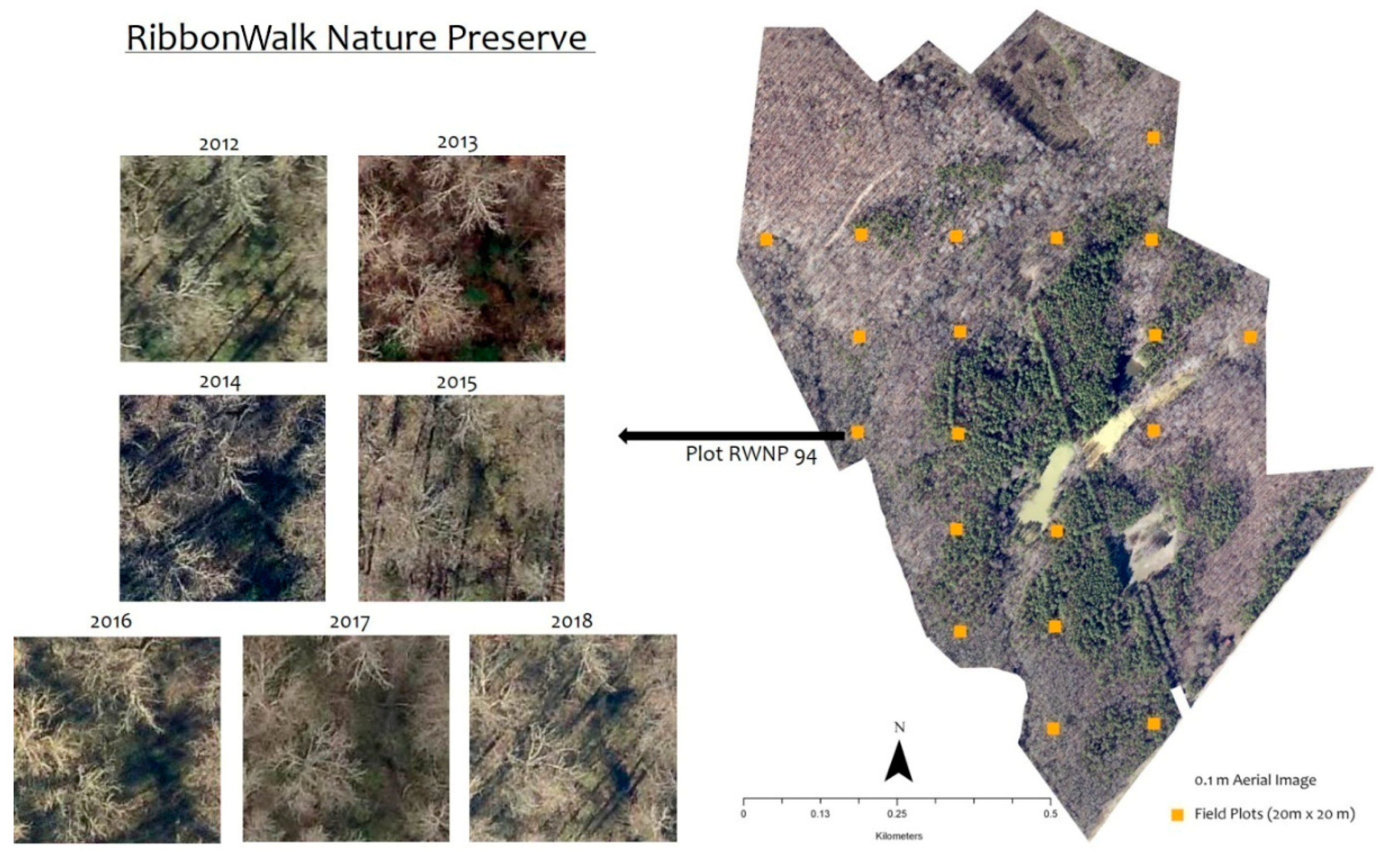
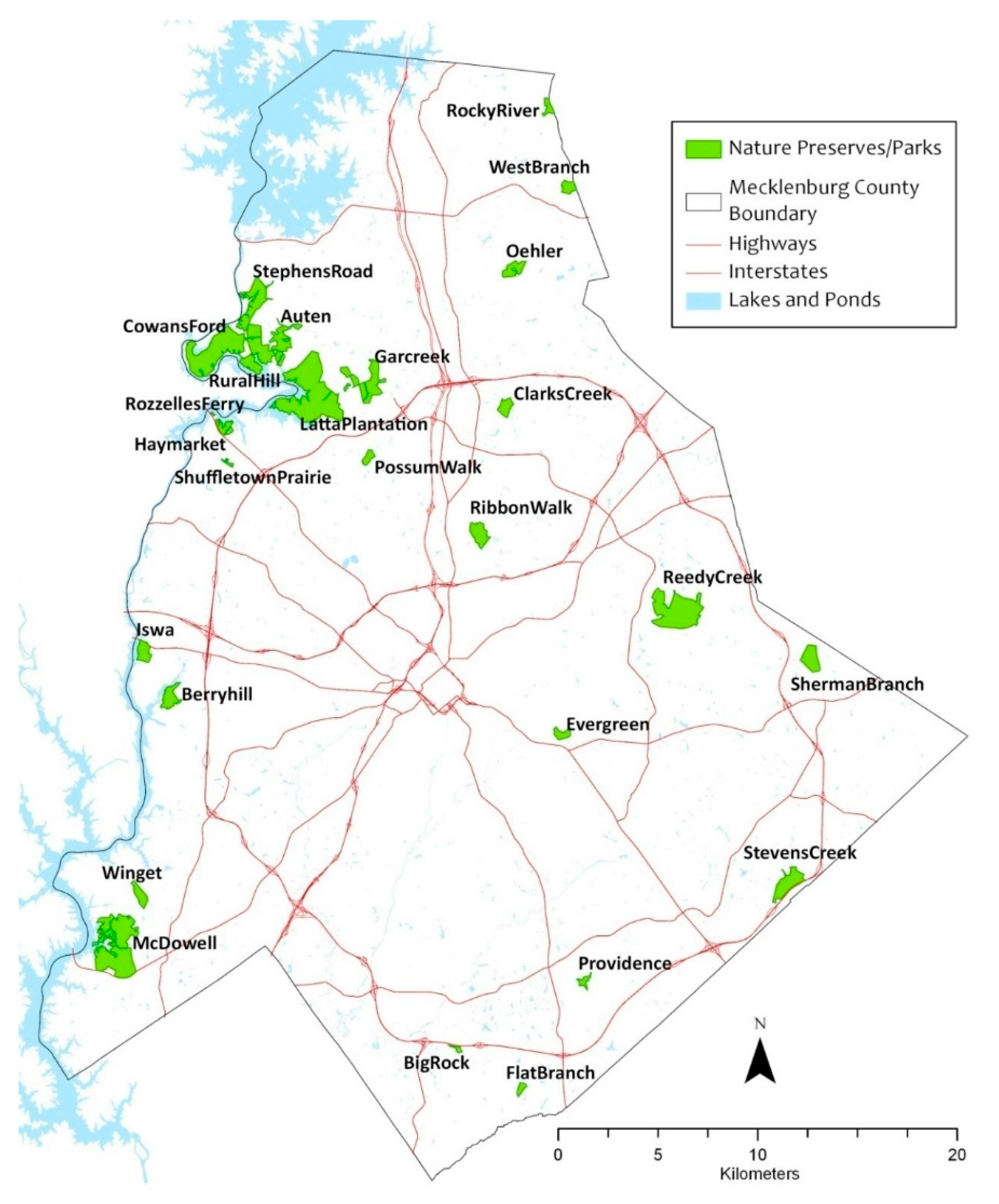
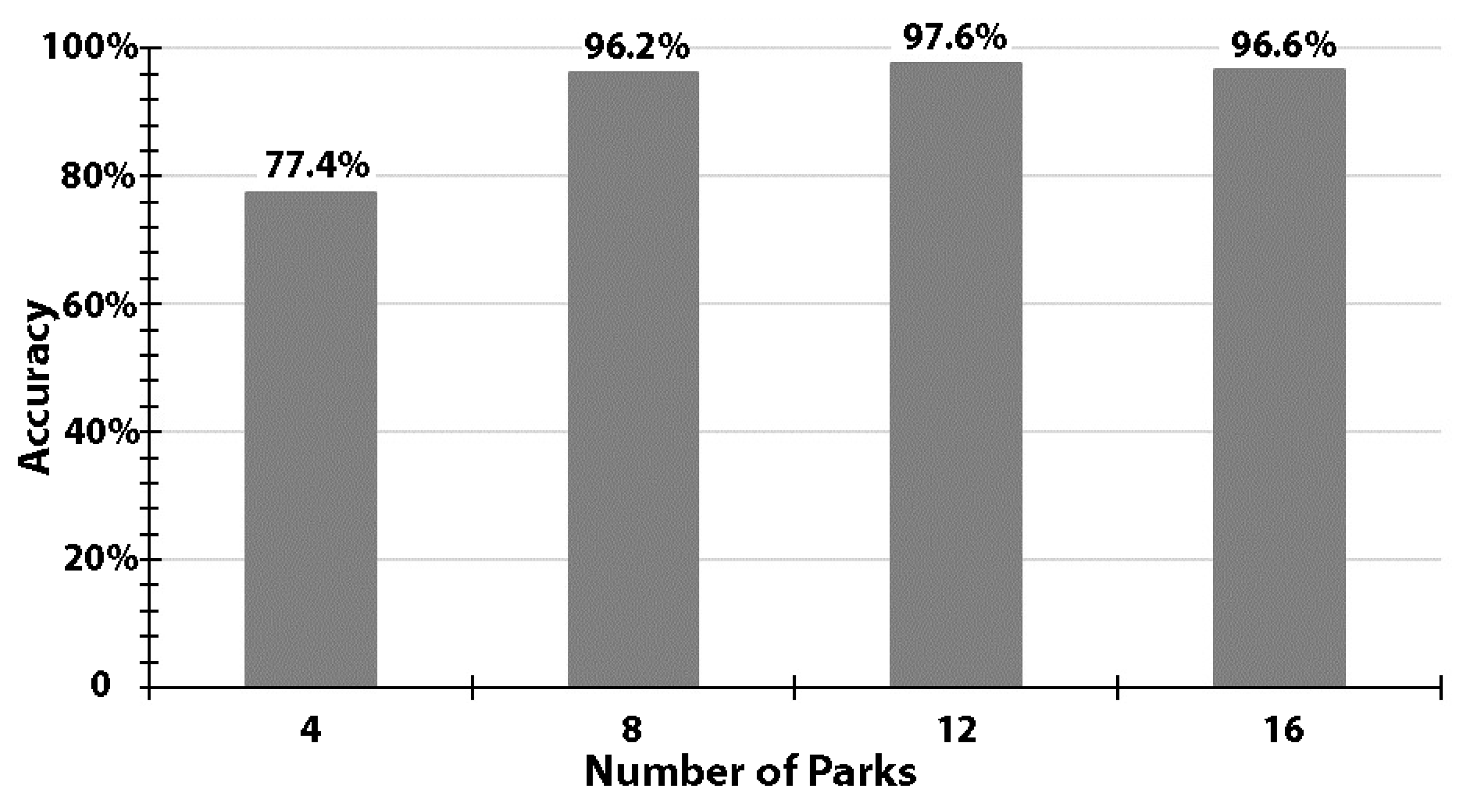
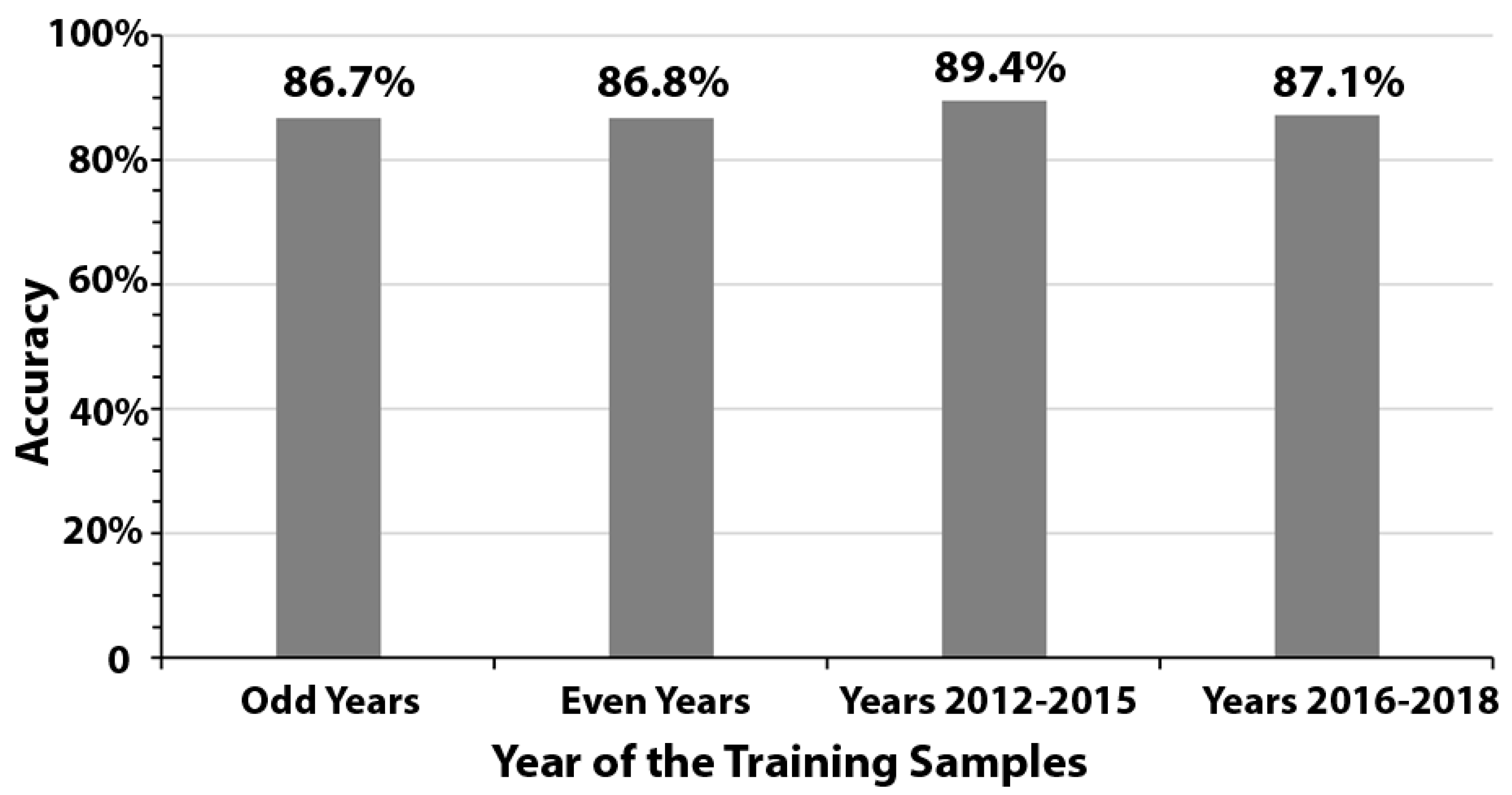
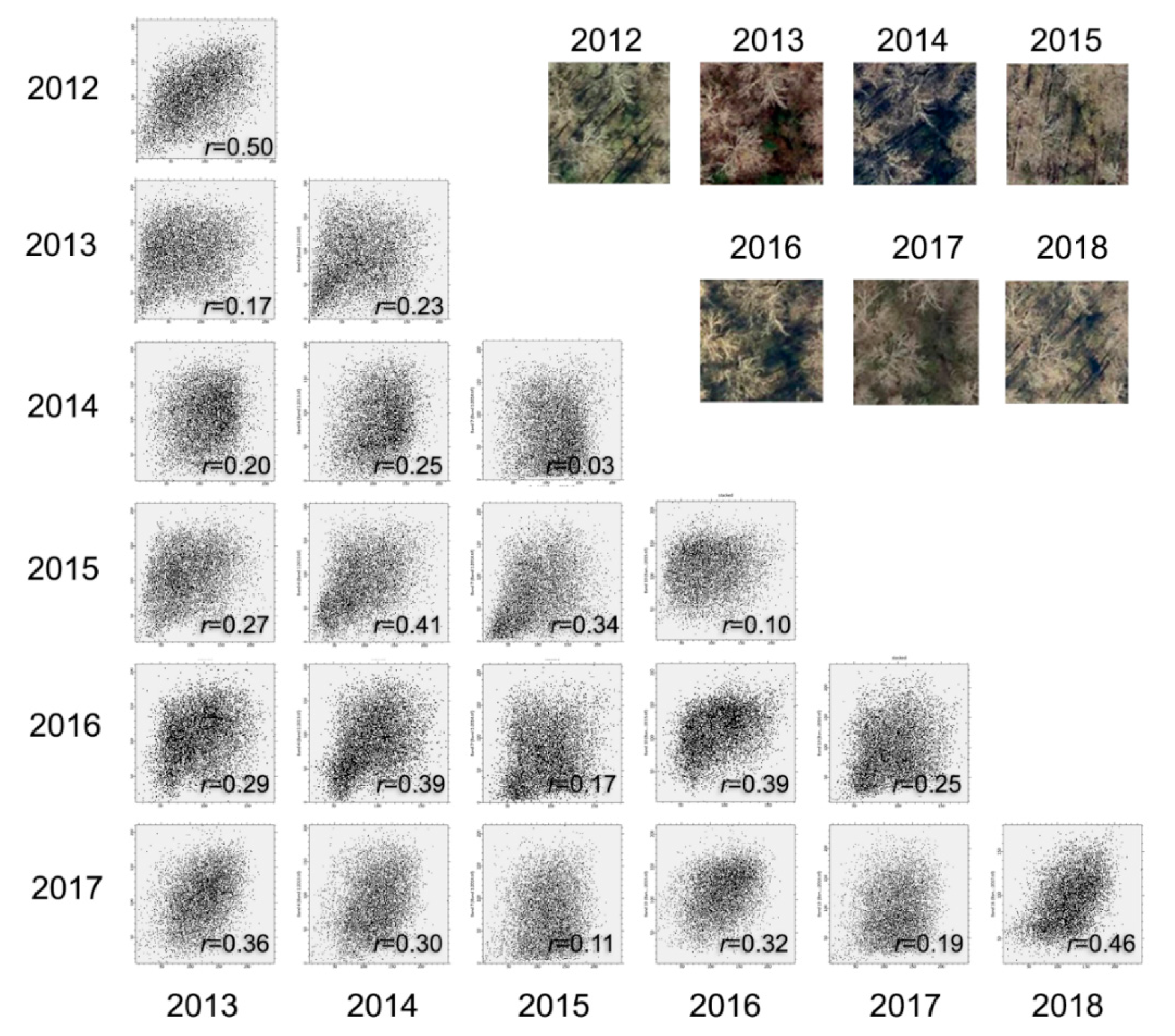
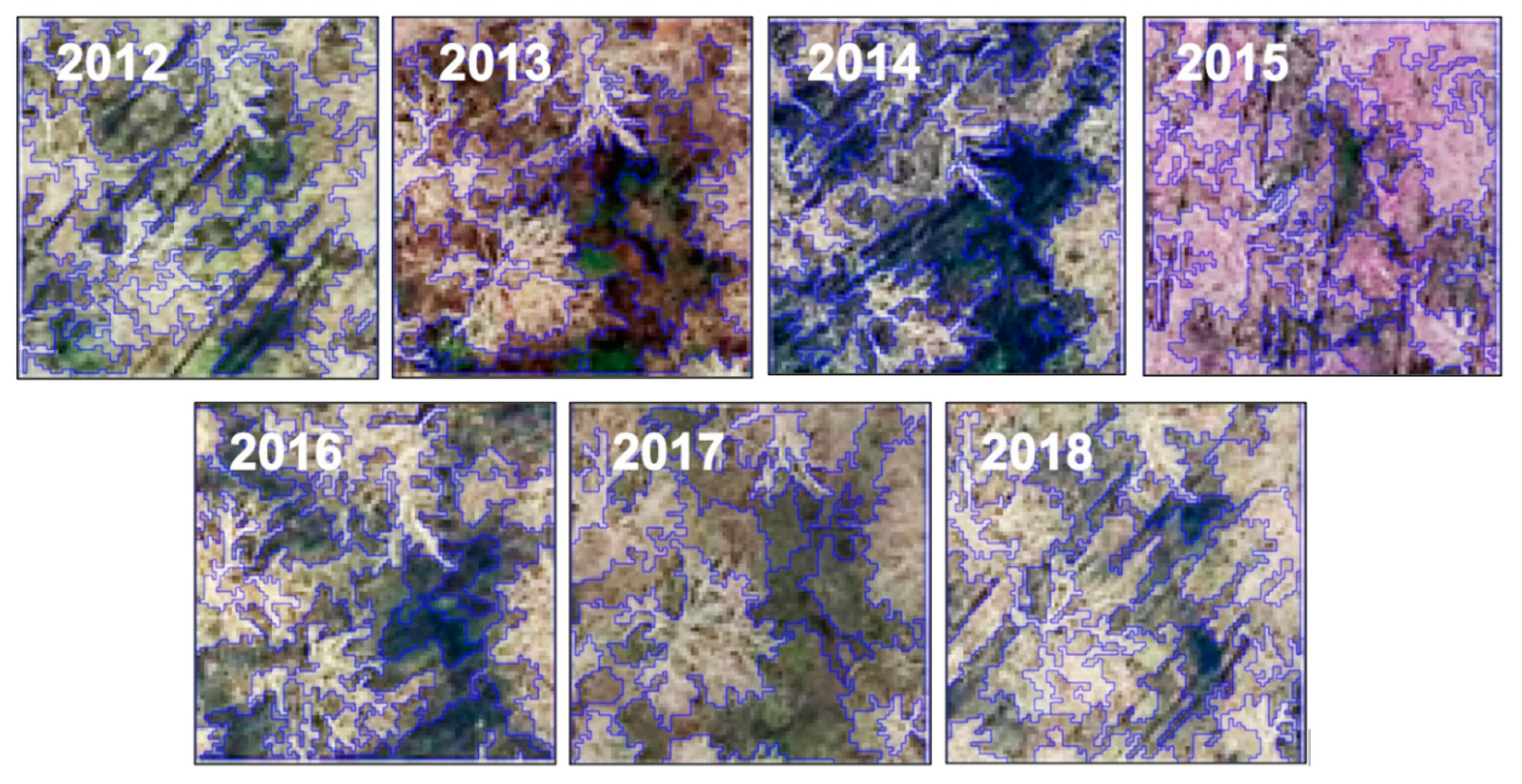
| Evaluation | Epoch | Batch Size | Learning Rate | Number of Workers |
|---|---|---|---|---|
| One | 90 | 32 | 0.0001 | 4 |
| Two | 60 | 32 | 0.001 | 4 |
| Training Sample Size | Producer’s Accuracy (%) | User’s Accuracy (%) | Overall Accuracy (%) | Kappa Statistic | ||
|---|---|---|---|---|---|---|
| Presence of Autumn Olive | Absence of Autumn Olive | Presence of Autumn Olive | Absence of Autumn Olive | |||
| 4 | 73.9% | 80.5% | 77.2% | 77.5% | 77.4% | 0.55 |
| 8 | 95.6% | 96.7% | 96.5% | 95.8% | 96.2% | 0.82 |
| 12 | 97.8% | 97.5% | 97.5% | 97.8% | 97.6% | 0.95 |
| 16 | 96.0% | 97.2% | 97.2% | 96.1% | 96.6% | 0.93 |
Publisher’s Note: MDPI stays neutral with regard to jurisdictional claims in published maps and institutional affiliations. |
© 2020 by the authors. Licensee MDPI, Basel, Switzerland. This article is an open access article distributed under the terms and conditions of the Creative Commons Attribution (CC BY) license (http://creativecommons.org/licenses/by/4.0/).
Share and Cite
Dutta, D.; Chen, G.; Chen, C.; Gagné, S.A.; Li, C.; Rogers, C.; Matthews, C. Detecting Plant Invasion in Urban Parks with Aerial Image Time Series and Residual Neural Network. Remote Sens. 2020, 12, 3493. https://doi.org/10.3390/rs12213493
Dutta D, Chen G, Chen C, Gagné SA, Li C, Rogers C, Matthews C. Detecting Plant Invasion in Urban Parks with Aerial Image Time Series and Residual Neural Network. Remote Sensing. 2020; 12(21):3493. https://doi.org/10.3390/rs12213493
Chicago/Turabian StyleDutta, Dipanwita, Gang Chen, Chen Chen, Sara A. Gagné, Changlin Li, Christa Rogers, and Christopher Matthews. 2020. "Detecting Plant Invasion in Urban Parks with Aerial Image Time Series and Residual Neural Network" Remote Sensing 12, no. 21: 3493. https://doi.org/10.3390/rs12213493
APA StyleDutta, D., Chen, G., Chen, C., Gagné, S. A., Li, C., Rogers, C., & Matthews, C. (2020). Detecting Plant Invasion in Urban Parks with Aerial Image Time Series and Residual Neural Network. Remote Sensing, 12(21), 3493. https://doi.org/10.3390/rs12213493








